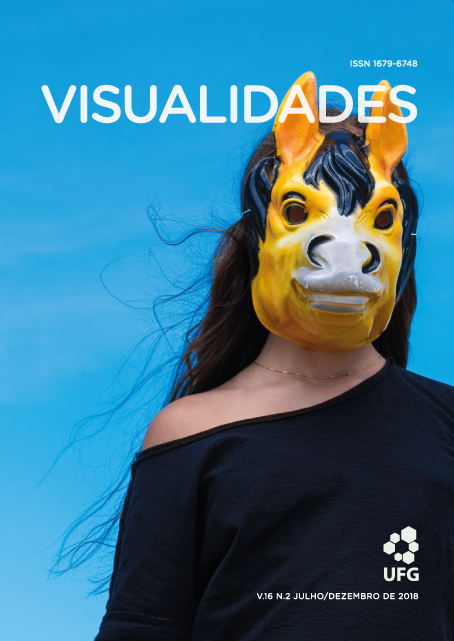Apropriando-se de Johannes Vermeer: revisitando o século XVII
DOI:
https://doi.org/10.5216/vis.v16i2.56391Keywords:
Appropriation, Contemporary art, Johannes VermeerAbstract
This article intends to discuss some procedures involved in the concept of appropriation, relating it to the various dialogues that emerged in the current visual culture around the Dutch painter Johannes Vermeer. The idea of appropriation assumes that the culture and specifically the images produced over the centuries in the visual arts belong to us and constantly build our imagination. Rather than denying the past to assert an alleged originality, the contemporary artist is not afraid to recreate from existing works, creating a dialogue between the past and the present. We will reflect on the significance attributed to this artist today.
Downloads
References
ALPERS, Svetlana. A arte de descrever: a arte holandesa no
século XVII. Tradução Antonio de Pádua Danesi. São Paulo:
Edusp, 1998.
AGAMBEN, Giorgio. Aby Warburg e a ciência sem nome.
Arte&Ensaios, Rio de Janeiro, n. 19, p. 132-143, jan. 2010.
[Dossiê Warburg].
BAL, Mieke. Fragments of matter – Jeannette Christensen.
Bergen: Kunsthogskolen i Bergen, 2009.
______. Quoting Caravaggio. Chicago; Londres: The
University of Chicago Press, 1999.
BAXANDALL, Michael. Padrões de intenções. A explicação
histórica dos quadros. Tradução Vera Maria Pereira. São
Paulo: Companhia das Letras, 2006.
BLADE Runner, o caçador de andróides. Direção: Ridley
Scott. Los Angeles: Warner Bross, 1982. 1 DVD (117 min),
widescreen, color.
BURKE, Peter. Testemunha ocular. O uso de imagens
como evidência histórica. Tradução Vera Maria Xavier dos
Santos. São Paulo: Editora Unesp, 2017.
CHEVALIER, Tracy. Moça com brinco de Pérola. Lisboa:
Temas e Debates, 2004.
DIDI-HUBERMAN, Georges. Diante do tempo. História
da Arte e anacronismo das imagens. Tradução de Vera Cruz
Nova e Márcia Arbex. Belo Horizonte: Editora UFMG, 2016.
_________. A imagem sobrevivente. História da arte e
tempos dos fantasmas segundo Aby Warburg. Tradução Vera
Ribeiro. Rio de Janeiro: Contraponto, 2013.
HERNÁNDEZ, Fernando. De qué hablamos cuando
hablamos de Cultura Visual? Revista Educação e Realidade, v.
, n. 2, jul./dez. 2005. Disponível em: <http://seer.ufrgs.br/
educacaoerealidade/article/view/12413>. Acesso em: 29 dez.
HOWELL, Brian. The dance of geometry. Nova Iorque:
Toby Press Ltd, 2002.
MONTIAS, John Michael. Vermeer and his millieu: A web
social history. Princeton: Princeton University Press, 1998.
SALGUEIRO, Heliana Angotti. Introdução. In: BAXANDALL,
Michael. Padrões de Intenções. A explicação histórica
dos quadros. Tradução Vera Maria Pereira. São Paulo: Companhia
das Letras, 2005.
SCHNEIDER, Robert. Vermeer. Lisboa: Taschen-Público,
SHOUP, Barbara. Vermeer’s Daughter. Zionsville: Guild
Press Emmis Publishing, LP, 2003.
SWILLENS, P. T. A. Johannes Vermeer, painter of Delft
–1675. Utrecht: Spectrum, 1950.
VREELAND, Susan. Girl in Hyacinth Blue. Denver:
MacMurray & Beck, 2002.
WEBER, Katharine. A Lição de Música. Lisboa: Temas e
Debates, 2000.
WHEELOCK JUNIOR, Arthur K. Johannes Vermeer.
Washington; Haia; New Haven; Londres: National Gallery of
Art; Royal Cabinet of Paintings Mauritshuis; Yale University
Press, 1995 [catálogo].
Downloads
Published
How to Cite
Issue
Section
License

This work is licensed under a Creative Commons Attribution 4.0 International License .
Authors who publish in this journal agree to the following terms:
a. Authors retain the copyright and grant the journal the right of first publication, with the work simultaneously licensed under the Creative Commons Attribution 4.0 License which allows the sharing of work with acknowledgment of authorship and initial publication in this journal.
b. Authors are authorized to take additional contracts separately, for non-exclusive distribution of the version of the work published in this journal (eg publish in institutional repository or as a book chapter), with acknowledgment of authorship and initial publication in this journal.
c. Authors are allowed to publish and distribute their work online (eg in institutional repositories or on their personal page) after the initial publication in this journal, as this can generate productive changes, as well as increase the impact and citation of the published work ( See The Effect of Free Access).
Every effort has been made to identify and credit the rights holders of the published images. If you have rights to any of these images and have not been correctly identified, please contact the Visuals magazine and we will publish the correction in one of the next issues.






